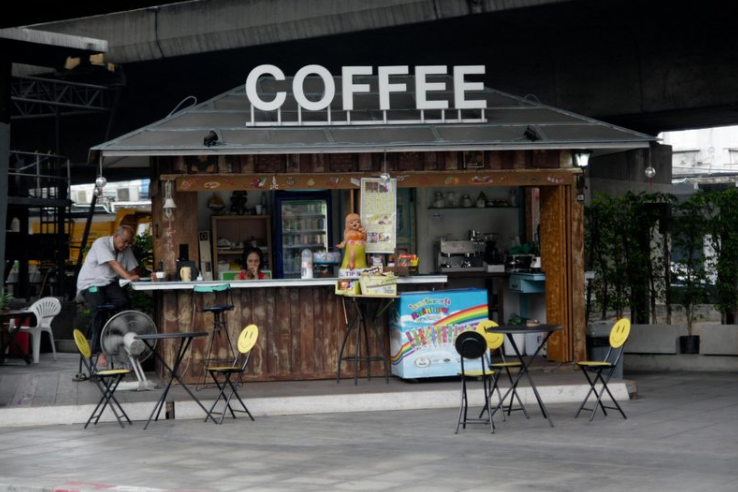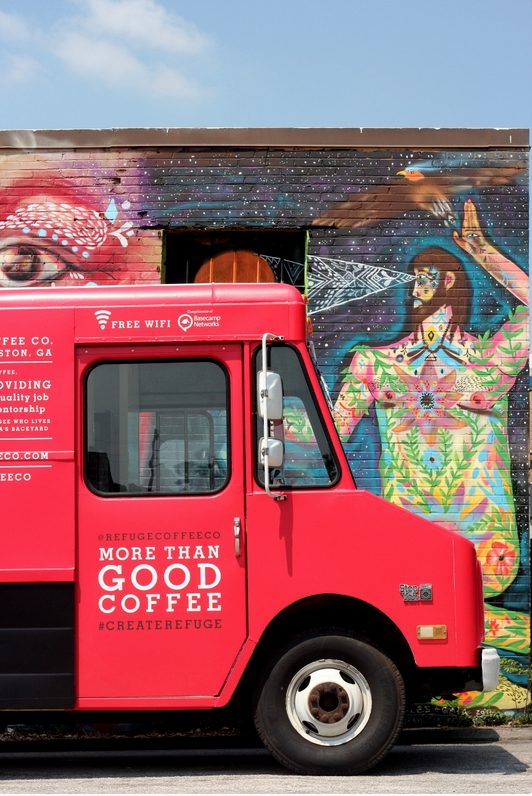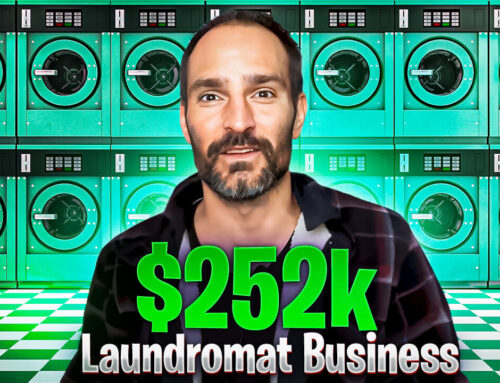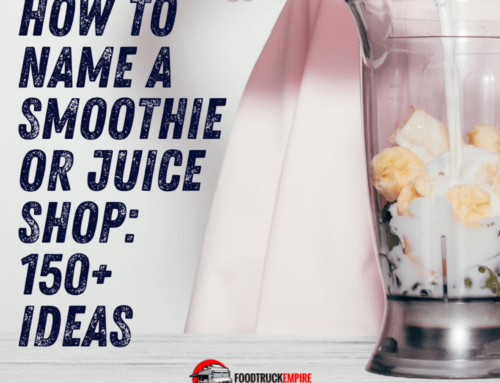Planning to start a drive-thru coffee kiosk or shop? Then you owe it to yourself to draft a well researched business plan. While a drive-thru kiosk is lower in cost than opening a retail store, be prepared to invest $40,000 at least before you open the serving window to your establishment for the first time. Your overall startup costs will likely be around $100,000 depending on the permits, insurance, equipment, location, size of the kiosk and design. Bottom line you need to take a coffee shop startup seriously because we’re talking about real money here.
When you approach researching a business plan the right way, it increases your odds of success. A real business plan takes time to prepare and eventually birth into the world. The point of the planning process is not to check off boxes to show you did something like you may have done for a course in college back in the day. Instead, the entire point is to better understand the business you’ll be operating. After you complete your business plan you should have answers to the following important questions:
- How do I plan to bring in customers to my business?
- What if my first idea to attract customers doesn’t work as well as I though (gasp!)? Do you have a back-up plan to make sales?
- How much will it cost to start my coffee kiosk? What equipment will I need to invest in?
- Where will I source my coffee, cups, stir straws?
- Will I have employees or do all the work myself?
- How much net profit can I expect to make per cup of coffee?
- How will you differentiate your business from the nearby Starbucks location?
If you can’t answer the questions above than you haven’t done enough research yet. Fortunately, by following the steps laid out in this business plan training document, you’ll be able to find answers to each of these questions.
At the bottom of this post you’ll also find helpful PDFs and business plan examples for coffee shops. We recommend taking the opportunity to look under the hood of these plans and see how these other coffee businesses operate profitably. With the increased footprint of nationally recognized coffee brands like Starbucks or Caribou Coffee, it won’t be easy to launch your own premium coffee shop. But through careful planning, an ability to create a unique customer experience, and determination to work your butt off it is possible to create a thriving coffee business!

Attractive Drive-Thru Coffee Shop. Photo Credit: Pinterest
Key Components of a Coffee Kiosk Business Plan
Executive Summary
Think of the executive summary as a quick explanation of your business. After reading the executive summary, the reader should come away with a clear understanding of what service or product need the organization provides. In other words, you’ll briefly describe you are doing and how will you make money.
While you’ll want to spotlight unique advantages in this section, save the detailed supporting evidence, including charts and graphs for future sections of the report. Another way to think about this section of the business plan is like the back cover of a novel. When you read the back cover of a book you expect come away with an understanding of what the story is about, but you’ll need to read the book to get the full story and details. The same goes for the executive summary.
Since the goal in writing your business plan is to open a drive-thru coffee shop, the organization of this section is less critical than someone requiring a few million to launch a business idea.
You will likely be using this business plan as a way to get clear on the costs, operation plan, and details of your future business, not secure millions in capital. This section is still a requirement for future kiosk owners, however, as you’ll in most cases need to provide a business plan to demonstrate seriousness and viability.
While you shouldn’t be overly concerned about the structure of this section, Inc.com offers good suggestions for the content of this section. A description on how this section might look for a coffee business is below:
Company Description
Natural Blend’s Roasters is a drive-thru coffee shop that will serve sustainably sourced and organic coffee’s to residents in Temecula, California. The company will differentiate itself by telling the story of it’s coffees sourced from around the world. In addition to offering flavor profiles and taste combinations not available elsewhere in the city, we will contribute 5% of all revenue to charity.
The problem.
Temecula, California, is covered in chain coffee shops (Starbucks, McDonalds). The competition does not offer organic, sustainably sourced coffee offerings. This is also an area traveled by commuters that drive to San Diego or Los Angeles for work Monday – Friday. Some coffee shops do not offer drive-thru service that are more convenient for this group.
Your Solution
Our goal is to fill the gap in this area by offering a fast and convenient naturally sourced coffees that are not available elsewhere. Our coffee kiosk will be located just off the I-15 freeway enabling commuters to quickly purchase a cup of coffee and light breakfast.
Why now?
The city of Temecula has steadily grown in population since the 1990s. In 1990, the city had only 27,000 residents. Fast forward to 2016, the population was 113,000. More families continue to move to the area in part due to more affordable housing in Southern California. Although housing is affordable, many high-paying jobs are located in San Diego or Los Angeles areas meaning that many of the residents commute 5-days per week.
Natural Blend’s Roasters plans to establish a brand in this growing Southern California town that does not currently have competition in the organic coffee space. We intend to build our brand in Temecula and expand to other nearby Southern California cities.

Outdoor Coffee Kiosk. Photo Credit: Pinterest
Company Description
The company description comes right after the executive summary. Here you will offer additional detail about your company that was not already covered in the summary. Some details you should include in this portion includes your coffee shop’s location, how large the company is, and what you plan you do.
You’ll also need to provide a brief mission statement in this area. This statement should be brief and provide an overarching direction for the business.
Mission Statement: We seek to provide an organic, responsibly sourced boutique coffee blends unavailable elsewhere in the Temecula / Murrieta area. We will serve our customers with a drive-thru coffee kiosk that will make this offering more convenient for our customers and seek to make our community a better place.
Market Analysis For a Drive-Thru Kiosk
The market analysis will evaluate key components critical to your small business. First, you will research the market size where you plan to operate. Fortunately, you don’t need to live in a big city to make a family-run coffee shop profitable. A town with 20,000 residents or more can provide a sufficient customer base. Thanks to the power of the internet, you won’t need to invest much time researching the market size and demographics. A few quick Google searches should yield the information you need for the first part of the market analysis like the one below:
Natural Blend’s Roasters will be located in Temecula, California. As of 2016, the population of Temecula was 113,000. Since 1990, the city has continued to grow by over 2,000 residents per year. We anticipate continued population growth over the next 5 years, which will benefit our business and bring in more potential customers. The median age in Temecula is 34 years of age. Roughly 68% of the population considers themselves Caucasian, 10% Asian, and 4% African American. There is also a significant Hispanic population as well.
One of the other advantages of operating in Temecula is that is has become a weekend destination for residents all over Southern California. Each weekend thousands of visitors drive to the Temecula Wine Country to enjoy wineries and dining. A significant number of breweries have also popped up in recent years that are attracting even more visitors. Our location off of the I-15 freeway will make us highly visible to visitors and offer a unique coffee experience that’s not available anywhere else in the area.
According to recent reports, coffee is consumed even more frequently than it was 5-years ago. On average in the United States, coffee drinkers consumer 3.1 cups per day. Independent coffee shops in the United States contribute $12 billion in annual sales. We hope to take a cut of this growing market within the Temecula / Murrieta area.
In the next section of the market analysis plan you will evaluate the strengths and weaknesses of local competitors. You should be looking for ways to integrate strengths and learn from what other coffee shops are doing wrong to serve unfulfilled needs locally.
Competitor #1: Starbucks – Globally recognized coffee chain with multiple retail and kiosk locations inside of grocery stores and Target.
Strengths:
- Brand recognition
- Over 10 locations in the Temecula / Murrieta area.
- Customer loyalty.
- Consistent product offering and experience across locations.
- Free Wifi for guests.
Weakness:
- Some people don’t like Starbucks coffee.
- Market saturation. There are over 10 locations / kiosks in the Temecula / Murrieta area.
Competitor #2: The Liquid Leaf – Independent coffee shop located in Murrieta.
Strengths:
- High-quality coffee.
- Wide variety of high-quality teas.
- Nice and comfortable interior.
Weakness:
- Less market awareness than other shops.
- Single location, independent shop.
- Some people incorrectly believe they only serve tea.
- No drive-thru service.
Competitor #3: Intazza Coffee Works – Honest Trade coffee shop located near a well attended church and business park.
Strengths:
- Beautiful and spacious coffee shop.
- Wide selection of cold brews, coffees, and small plates.
- High-traffic location.
- Strong overall branding and mission statement.
- Wine, beer, and music on Friday nights.
Weakness:
- No drive-thru service.
- Near other independent coffee shops.
Organizational Structure and Management
This is your opportunity to define the team member roles inside your organization. If you’re starting a small drive-thru kiosk, the initial management structure may be very simple: You’ll the be the CEO, head barista, and janitorial staff all in one! If this sounds like your situation, you won’t need to invest much time into developing this section of the business plan.
We also know that many of you will be running this business with a family member or partner. Even if you plan to operate the kiosk as a true two-person partnership this is a terrific opportunity to define clearly define each persons role inside the business. A clear role definition between partners is essential to ensure you’re both on the same page and prevent future issues.
In the planning stages of a business, it can be easy to overlook the often mundane aspects of operating a business. For example, who will do the book-keeping on a regular basis? How much will each business owner be paid as a salary? What days and hours will each part of the business? Who will be in charge of marketing? How will be in charge of ordering more coffee beans from the supplier? Getting the responsibilities of each partner on paper helps to clear up future misunderstandings that will happen after opening the business. This also helps to prevent feelings that one partner is working harder to make the business succeed than the other.
In addition to partners of the business, you’ll need to list employees and advisers you’re bringing on advise the business. If you hire an experienced mentor to offer coaching in the early days it can also help you to secure a loan because you’re business is more likely to succeed and help demonstrate seriousness.
Finally, here’s an example of how simple the organizational structure could look in a partnership in a small coffee shop:
Sally, Co-Founder / Owner. Roles: Handles day-to-day management of coffee shop Monday – Friday. Orders supplies and maintains inventory for business,
Betty, Co-Founder / Owner Roles: Manages book keeping / accounting for business, Day-to-Day management of coffee shop Saturday – Sunday. Secures catering, events, and completes marketing for the business.
Charles, Part-time Barista – Employee, Roles: Serve customers, make coffee, clean kiosk, provide excellent customer service.
Pete, Part-time Barista – Employee, Roles: Serve customers, make coffee, clean kiosk, provide excellent customer service.
Product Line
Here you will list the types of coffees and food items you plan to serve at your coffee kiosk. In addition to beverages, it’s a wise idea to offer snacks or quick breakfast items to increase your average order value and total revenue for your business. Don’t feel obligated to make these side items yourself. If you notice with Starbucks, the food items are all pre-made and only need to be heated before served to customers. By serving already prepared items you remove preparation time, employee salaries (associated with food prep), and ensure faster service for customers. Here’s an example of what your menu might look like for a drive-thru coffee stand:
| Product | Menu Price | Cost |
Source – List source of product here.
|
| Small Drip Coffee | $2.00 | $0.50 | Grounds for Change |
| Medium Drip Coffee | $2.50 | $0.55 | |
| Large Drip Coffee | $3.00 | $0.60 | |
| Small Espresso | $3.00 | $0.55 | Grounds for Change |
| Medium Espresso | $4.00 | $0.60 | |
| Large Espresso | $5.00 | $0.65 | |
| Small Tea | $2.00 | $0.75 | |
| Medium Tea | $2.50 | $0.80 | |
| Large Tea | $3.00 | $0.85 | |
| Small Hot Chocolate | $3.00 | $0.70 | |
| Medium Hot Chocolate | $4.00 | $0.75 | |
| Large Hot Chocolate | $5.00 | $0.80 | |
| Small Cappuccino | $3.00 | $0.70 | |
| Medium Cappuccino | $4.00 | $0.75 | |
| Large Cappuccino | $5.00 | $0.80 | |
| Small Iced Coffee | $3.00 | $0.75 | |
| Medium Iced Coffee | $4.00 | $0.80 | |
| Large Iced Coffee | $5.00 | $0.90 | |
| Organic Blueberry Muffin | $3.50 | $2.50 | Simple Mills |
| Organic Chocolate Muffin | $3.50 | $2.50 | Simple Mills |
| Organic Apple Slices (Bag) | $3.00 | $2.00 | Albertson’s Grocery |
| Organic Bananna | $2.00 | $0.75 | Albertson’s Grocery |
| Organic Granola Bar | $3.00 | $2.00 |
Note: Don’t forget to be as specific as possible in the business plan on where you plan to source products. If you have time, research your options for similar products from other vendors. In the event one of your vendors increases prices or goes out of business, you’ll already know where you can turn to source alternative products and keep things running smoothly.

Refuge Coffee Co. Food Truck.
Funding Request
In this section, you’ll list how much money you’ll need to borrow or raise to get the business started. In addition to the total dollar amount you’ll need to get started, be as specific as possible where you plan to invest the funds. Acceptable places to invest include coffee equipment, the building, rent, or inventory. Whether you’re planning to raise capital through a bank loan or an investor, these individuals want to feel comfortable that money is being put toward a good use. Below is an example of a funding request for a coffee shop of any size:
Coffee Shop Funding Requirements:
Bunn Axiom APS Twin Commercial Airpot Coffee Brewer – $1,399.00
Rancilio MD 40 Commercial Burr Espresso Grinder – $900.00
Refrigeration Unit – $1,500.00
The Oracle Touch Espresso Machine – $2,499.95
Vollrath 40701 Cayenne Half Size Counter Top Convection Oven (230v) – $1,309.05
Water Filtration System – $2,750.00
Custom Coffee Shop Kiosk Build – $30,000
Working Capital: $15,000
Total Funding Requirements: $55,358
Note: Small businesses are almost never fully funded through outside sources. Both banks and investors will want you to have “skin in the game” by investing a significant portion of your own money into the startup. Business owners often use their personal savings or tap into their 401K to get the initial capital needed to fund their business.
Financial Projections for Coffee Kiosks
In this section, we are going to cover what is arguably the toughest part of the business planning: Estimating how much revenue you’ll make. This process is part science, part art, and some educated speculation too. Until you get out there into the world and start asking for money in exchange for your product or service, you never really know how it’s going to work so be ready to adjust these financial estimates in the weeks and months after you open.
While estimating the future revenues of a business that does not yet exist is difficult, that doesn’t mean it’s unimportant. This section will provide you with insight into the sales volumes you need to achieve a break-even point after expenses. This section forces you to take a hard look and determine the financial viability of the business before taking another step forward. By the time, you get done projecting your sales figures, you may determine this business opportunity is ultimately not for you. That’s totally okay! You’ve got to make sure you’re starting a business with the potential to provide the lifestyle you want.
Income Expectations
In this area we’ll evaluate how much you can expect a drive-thru coffee shop to make in revenue each year. There are a few ways to being your research in this area. The first is simple enough start researching how much income independent coffee shops generate annually. According to this report from 2011, the typical coffee shop generated $500,000 in annual revenue.
While this might sound like a pretty good annual revenue, keep in mind that these don’t offer much context to each coffee shop’s situation. These reports don’t tell you where the shops are located and how long they’ve been in business. The other flaw with being average is understand that half of the coffee shops make less than this number annually. It’s also a harsh reality that more than 50% of coffee shops will close their doors within the first 5-years of business.
When estimating revenue numbers for a small coffee business, we recommend being conservative with your sales figures. Even with the best spot in town, it will take time people to discover you. Here are some estimates that will influence your own sales figures:
Hours of Operation: The longer you’re open, the more opportunity you have to generate sales. That being said, you probably don’t want to be open 24/7 because that would be both exhausting and higher in cost from a labor standpoint. Most coffee shops do the majority of their sales in the early morning and afternoon hours so we’ll assume the same to be true for your business.
You’ll also need to consider how many days you’ll want to be open each week. You’ll also need to ask yourself if you want to be open major holidays like Thanksgiving and Christmas Eve. While you may decide to be closed for certain holidays that is perfectly acceptable. Just make sure to account for these days off in your planning as you won’t make sales on days you’re closed.
Estimated Daily Sales for a Coffee Kiosk:
Below is an example of hours of operation for a coffee kiosk.
5 a.m. – 3 p.m. Daily. – 10 hours per day. 7 Days per Week.
Using these hours, you have 70 total vending hours per week assuming no holidays. To keep the numbers simple, let’s estimate that you plan to sell 100 large cups of drip coffee per day at $3.00 a piece. This means you’re expecting to sell 10 cups of coffee per hour on average. At this rate, you’ll generate $300 in sales per day. This is a pretty conservative number considering many customers will order more than one cup of coffee or a snack. Still, these conservative numbers are smart approach when determining the viability of this business.
$3.00 Average Sale X 10 Average Transactions Per Hour = $2,100 per week in average revenue. Applying some basic math you would be yielding $8,400 per month. Annual sales numbers would be $100,800. Again, these numbers assume you are open for business 365 days per year and sell the same amount each day.
At this stage in your business, it’s acceptable to play around with the numbers a bit. Understand how much extra revenue you could generate by increasing your average order value to $4.50 instead of $3.00. Estimate what you business would look like if you increased average transactions per hour to 15 (not an unrealistic number for a coffee kiosk).
In reality your sales volume will change on different days and times of the day. Here’s a closer to real-life example of what a daily sales of a well-run coffee kiosk might look like:
- Monday: $400
- Tuesday: $275
- Wednesday: $225
- Thursday: $525
- Friday: $600
- Saturday: $800
- Sunday: $600
Total Revenue: $3,425 for the week (Or $13,700 per month, or $164,400 per year.)
Factors that Directly Influence Future Sales:
As a business owner there are plenty of things you can do to increase revenue of a business. Here are some of the options available to you to increase revenues:
- Location: If you’re located in a busy parking lot next to a grocery store or off a major highway, you can expect to generate more sales. Finding the right location for your business is critical for it’s success.
- Average Order Value: If you’re able to increase the average sale amount, you can add a lot of money to the bottom line at the end of the year.
- Frequency of Visitors: In addition to finding more customers, getting the same customer to visit your kiosk 2 – 3 times per month can really increase bottom line metrics.
- Marketing: This broad category includes your signage, personal relationship, networking skills, and social media marketing skills.
- Catering and Event Business: By adding a catering arm to your coffee business, you can immediately add thousands in annual revenue to your small business. The success of catering and event businesses can be the difference between success and failure for coffee cart businesses.
Expenses For a Coffee Kiosk
Startup Costs:
- Drive-Thru Coffee Stand: Pricing depends largely on size and type of structure. Kiosks, carts, shipping containers, trucks and stands can all be utilized for this business.
- Construction: Curb modifications, landscaping, lighting, electrical or signage installation.
- Coffee Shop Equipment: Espresso machines, water purification systems, refrigeration units.
- Initial Inventory: Coffee beans, creams, syrups, cups, straws, sugar, napkins.
- Point-of-Sale System / Cash Register
Total startup costs are extremely variable. On the low-end you can start a drive-thru coffee kiosk for around $40,000. After considering minor construction updates to the vending area and commercial grade coffee equipment you can expect to pay $100,000 – $150,000 all-in for startup costs.
Monthly Business Costs:
- Cost of Goods Sold (COGs):
- Rent:
- Labor:
- Debt Payments (If Any):
- Insurance:
- Utilities:
- Accounting / Bookkeeping:
- Marketing:
Additional Resources
Business Plan Template: Looking for more examples of a business plan that you can download? Check out our previous podcast interview / template created by a food truck vendor.
POS System: If you’re planning to open a coffee kiosk, you’ll need a way to accept credit card payments fast and safely. Learn more about the point-of-sale systems we recommend for food and beverage businesses.
Coffee Business Startup Costs: An estimate of all he costs associated with opening a coffee business.
How Much Does a Drive-Thru Coffee Stand Make in a Year?: Annual estimates and opinions from a variety of folks on Quora.
Looking for additional resources to help you start a coffee kiosk? Here’s some of the best we’ve found published online. The PDF below for a company called The Daily Perc is worth checking out while you’re still in the business planning phase.




